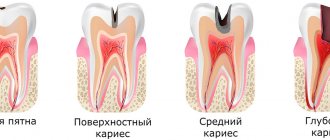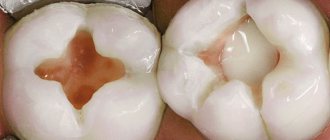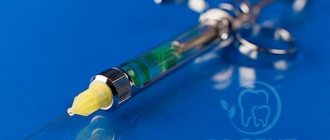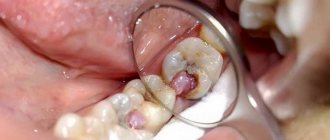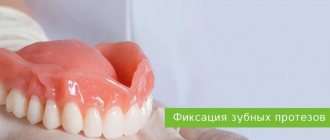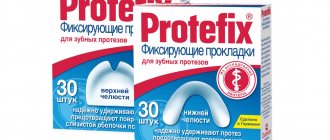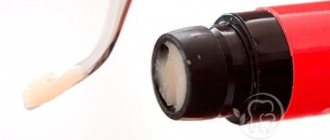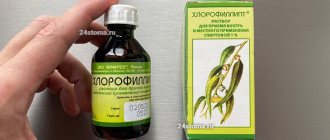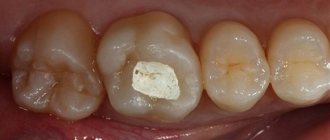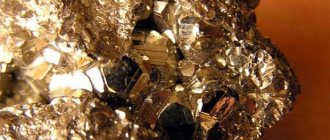Caries is a common dental disease that destroys the hard tissues of teeth. According to statistics, it affects about 95-98% of the population of economically developed countries. In the treatment of caries, medicinal pads can be used. In what cases and for what they are used, we will tell you in this article.
In this article
- What is a therapeutic pad in dentistry?
- In what cases is a lining used for caries?
- Why are medicinal pads used in the treatment of deep caries?
- How is a therapeutic napkin installed for deep caries?
- Materials of therapeutic pads
- How do combined pastes work?
- Pros and cons of using medicinal pads in dentistry
In what cases is a lining used for caries?
Caries is a slowly progressive pathological process that goes through several stages. At an early stage, a carious lesion looks like a light spot on the enamel, while there is still no hole or pain in the tooth. As the disease progresses, the spot turns into a carious cavity. At the stage of superficial caries, this cavity is located within the tooth enamel; with medium and deep caries, it affects dentin tissue.
For caries in the spot stage and the superficial form of the disease, pads with a therapeutic effect are not needed; for average caries, they can be used according to indications. Most often, medicinal dental pads are used for deep caries. The peculiarity of deep caries is that the carious cavity is located as close as possible to the pulp - the neurovascular bundle, or dental nerve. At this stage, treatment is quite painful and there is a high risk of complications in the form of pulpitis and periodontitis.
Dental linings help increase the effectiveness of treatment of deep caries.
Reviews about our dental therapists
I would like to express my gratitude to the dentist Elena Nikolaevna Kiseleva and her assistant Svetlana - they are real specialists and at the same time sensitive, not burnt out by years of practice.
Thanks to them, I have been coming back here for many years. Thanks to the management for such doctors! Read full review Svetlana Nikolaevna
13.08.2021
Words cannot express my gratitude to Elena Nikolaevna Kiseleva. This is the best doctor in the world. I got an appointment after many years of being ignored by the dentist’s office and with a bitter experience of treatment in another paid clinic, the mistakes of which had to be corrected in the first visits. Thank you for this... Read full review
Roman Stanislavovich Sh
25.07.2020
Why are medicinal pads used in the treatment of deep caries?
The purpose of a healing pad is to protect the pulp. After the dentist has removed the tissue affected by caries, cleaned and prepared the carious cavity for filling, a very thin layer of dentin, the bone tissue of the tooth, remains between it and the dental pulp. This creates a high risk of microbes entering the dental nerve and developing pulpitis. To prevent the spread of infection into the pulp, stop the inflammatory process and stimulate the production of a new layer of dentin, a special gasket is applied.
When a gasket is temporarily applied, the entire carious cavity is covered with it and a temporary filling is installed for a period of two weeks to several months. Permanent linings for deep caries are applied pointwise in the area of the tubercles of the neurovascular bundle. In the second case, along with the therapeutic one, an insulating gasket is installed.
Preparation
A qualified dentist places a Life lining only after preliminary preparation of the diseased tooth. If you begin the process of applying material without preparation, the quality of treatment will be low and the risk of negative consequences will be high.
Preparation includes:
- administration of anesthesia;
- dissection of affected tissues;
- removal of all necrotic tissue;
- drying the cavity.
The procedure is a preparatory stage before filling a tooth, but can only be carried out after high-quality treatment of the pathology and complete removal of tissue affected by caries.
How is a therapeutic napkin installed for deep caries?
Depending on the form and complexity of the disease, as well as the chosen method of caries treatment, the dentist can install the lining by direct or indirect application. The first option assumes that it is applied directly to the pulp area, ensuring direct contact between the gasket and the dental nerve. The method is used for tooth injuries with exposure of the nerve, for fibrous pulpitis. The second method is to apply a lining using dentinal tubules without direct contact with the pulp. It is often chosen for the treatment of deep stage caries and acute pulpitis.
Glass ionomer cements
Isolating pads of this type are used quite often in dentistry. They come in two types:
- modern;
- classic.
Let's talk in more detail about the second. Composition: glass made of aluminum, silicate, calcium plus liquid (polycarbonate acids). Everything is mixed mechanically. Advantages of SIC cement:
- the released fluoride fights caries throughout the year;
- strength;
- good adhesion without drying and etching;
- does not have an irritating effect on the pulp;
- low cost.
Now about the disadvantages:
- long hardening period – days;
- cannot be used in conditions of excessive humidity and dryness;
- Excess cement must not be removed using a drill.
Technologies do not stand still. In order to get rid of cosmetic defects, modern dental cement was created. It contains a light-curing resin. This material is called hybrid. It hardens when exposed to a lamp. The modern mixture is not so sensitive to moisture and drying out. But they cannot be used as a gasket.
Materials of therapeutic pads
Several types of dental dams are used in the treatment of deep caries:
- varnishes, solutions, light-curing cements and polymers based on calcium hydroxide;
- zinc-eugenol and combined pastes.
Preparations based on calcium hydroxide have a powerful bactericidal effect. The application of these compounds to the bottom of the carious cavity prevents the penetration of microbes into the dental pulp and the development of the inflammatory process. Calcium hydroxide also promotes the production of new bone tissue in the area between the cavity and the nerve of the tooth.
Aqueous suspensions based on calcium hydroxide are usually applied in a thin layer to the bottom of the carious cavity, dried and a temporary filling is placed on top. They are replaced after 30-45 days. Also, in the treatment of dental caries, chemically cured cements are often used. They are pastes containing ether and hydroxide in a 1:1 ratio. These pastes harden directly in the patient's mouth and have excellent insulating properties in relation to fillings. Light-curing polymers must be used very carefully, because there is a risk of burning the dental nerve. At the same time, they have very high strength and, in the hands of a professional dentist, can be an effective means of treating caries. Zinc-eugenol pastes are widely used as an antiseptic for temporary fillings.
Properties of the drug Dycal (Daykal)
Dycal is a calcium hydroxide-based cushioning material. The material is used to protect the pulp. The substance promotes the formation of secondary dentin.
The material has the following properties:
- clinically effective;
- hardens quickly;
- differs in strength in the early period;
- does not dissolve in oral fluid, is resistant to saliva;
- has a natural dentin shade or ivory color (Dycal Ivory);
- easy to apply, filling the necessary areas;
- does not affect the color of the final restoration.
The base composition includes calcium phosphate and tungstate, zinc oxide, iron oxide. The catalyst contains calcium hydroxide, zinc stearate, zinc and iron oxides. The cushioning material Daikal is characterized by high strength.
Instructions for use
Dycal is used as a therapeutic lining material before using the main filling material. The base and catalyst are mixed in equal proportions. The finished mass should have a homogeneous consistency, without streaks. Mixing is carried out within 10 seconds.
Before use, the dental cavity is washed and dried. The substance is applied in a thin layer: from 0.8 to 1 mm. You should not use very thin pins in your work. Remaining material is removed. Next, an adhesive or restorative material is applied. The working time of the material is 2 minutes 20 seconds, hardening occurs within two to three minutes.
Special information
When working with the drug, avoid contact with the skin and mucous membranes of the mouth and eyes. Upon contact, irritation, an allergic reaction, and a rash may occur. Ingestion of the product is prohibited. During restoration work, you should wear gloves on your hands and protective goggles on your eyes.
Gasket material Daikal
At high temperatures and humidity, the working time is significantly reduced, since the mass begins to harden much faster. In this connection, work is carried out at an air temperature of about 21 degrees, air humidity should not exceed 50%. After each use, the tube of material should be tightly closed. It is prohibited to use products that have expired.
The price of the drug ranges from 1,700 to 2,000 rubles.
Analogs of material:
- Vitrebond
ENDOFIL (Endofill) - filling material for root canalsViedent VladMiVa: instructionsPulposeptin in dentistryZincoxide eugenol paste for filling root canalsSilidont 2: instructionsCemfil 15 Stomadent
How do combined pastes work?
The composition of combined pastes includes oils, fillers (zinc oxide or white clay), as well as medications. The therapeutic effect of a particular pad directly depends on the latter:
- Stimulating dentin growth and promoting enamel remineralization. These drugs are called odontotropic, they are based on fluorides, collagen, calcium glycerophosphate and other substances. They are used when it is necessary to increase the layer of bone tissue between the pulp and a deep carious cavity.
- Possessing anti-edematous and anti-inflammatory effects. They help stop the inflammatory process in the dental pulp; they are based on prednisolone and hydrocortisone. Typically, such preparations are temporarily placed at the bottom of the cavity and covered with a bandage on top. If the dentin layer next to the neurovascular bundle grows too slowly, then a spacer with an odontotropic effect is applied.
- Pads with an antiseptic effect based on metronidazole or chlorhexidine disinfect and prevent the growth of bacteria.
- Proteolytic enzymes contained in the drug are needed in the treatment of acute focal pulpitis, as well as in the treatment of deep caries.
Most combined pastes harden poorly and have low strength, so they are used as a temporary therapeutic material. After their removal, a different type of therapeutic pad is usually used.
Varieties
In dental practice, therapeutic and insulating pads are used. They prevent the appearance of microcracks and prevent toxins from penetrating into the deep tissues of the tooth.
The following requirements apply to them:
- the ability to create long-term protection from irritants;
- protection of surface enamel from temperature differences and the aggressive action of saliva;
- ensuring strong adhesion to tooth tissues.
Medicinal
The purpose of using therapeutic spacers is to stimulate the formation of secondary dentin and protect the pulp chamber from harmful chemical and thermal influences.
Their installation also relieves the severity of the inflammatory process in dental tissues.
Dycal
It is a dental material in the form of a paste. The main active ingredient is calcium hydroxide. The main purpose is direct and indirect pulp coating.
It accelerates the formation of secondary dentin and ensures high strength of the filling. This action provides protection against the penetration of pathogenic microflora into deep tissues.
This type of gaskets has the following positive qualities:
- increased strength and quick results;
- biocompatibility allows use with various composite materials;
- the composition is resistant to salivary fluid (does not dissolve);
- It is well applied to the tooth surface, filling all the necessary areas;
- does not change the color of the surface enamel upon completion of the restoration.
The material is not used if the patient has an allergic reaction to its main or additional component.
It is important to know! Installation of Dycal gaskets must be done with extreme care. Avoid contact with the oral mucosa and visual organs. Therefore, you need to use safety glasses when working with this material.
Why does a dead tooth hurt when pressed and what to do in this case.
Come here to learn about the causes of gum necrosis after tooth extraction.
At this address https://www.vash-dentist.ru/lechenie/zubyi/karies/hronicheskiy.html we will consider the signs of chronic deep caries.
Life
Used as a cement base for direct and indirect pulp capping. The usual composition of Life hardens in 6 minutes. If you use Life for quick hardening, this process is reduced to 1.5 minutes.
The advantages of this composition include:
- promotes the formation of secondary dentin;
- does not interfere with the vitality of the pulp;
- has good performance under compression;
- compatible with different types of composite materials;
- is resistant to acidic environments;
- The optimal hardening period allows you to apply the drug in layers.
This type of dental dams is not used if an allergic reaction occurs to one of its ingredients.
Calcipulpe
The therapeutic effect is provided by calcium hydroxide and barium sulfate. The placement of this lining prevents the penetration of bacterial pathogens into the pulp chamber of the tooth.
The alkaline composition promotes the secondary formation of hard tissue. The big advantage of this type of gasket is its fast curing and no impact on the quality of the seals being installed .
Indications for use are:
- cases of deep caries development;
- use as a protective layer when opening the pulp chamber;
- to eliminate severe tooth sensitivity before prosthetics.
The paste is used after wide opening of the carious cavity and cleansing it of the rest of the destroyed dentin. If necessary, the material is applied several times, allowing for drying time for each layer.
Must be kept in mind! Intolerance to one of the components is a contraindication for installing a gasket.
Insulating
Installing a filling in some cases causes irritation and toxic effects on the pulp. Installing an insulating gasket eliminates these problems. At the same time, it creates a barrier against the penetration of bacterial pathogens.
Ionosil
It contains elements of composite and glass ionomer cement (includes fluorine and zinc). They are used when installing amalgam fillings or when a tooth is restored using ceramics. Possible use for sealing large carious cavities.
Positive qualities when using Ionosil are:
- improving the adhesive characteristics of the filling material and preventing the development of microcracks;
- no toxic effect;
- high strength, compression resistance, insolubility under the influence of acids;
- the content of fluoride and zinc prevents the re-formation of caries;
- the tightness of the canal closure minimizes the chance of post-filling pain.
Individual intolerance to one of the components limits the use of Ionosil.
Fuji Line
The powder contains aluminosilicate glass containing fluorine; polyacrylic acid or water is used as a liquid base. In addition to moisture resistance and increased strength, the fillings have the following positive qualities:
- good biological compatibility does not lead to irritation of tooth tissue;
- a high degree of adhesion makes the filling strong and durable;
- the presence of fluoride reduces the chance of developing recurrent caries.
The consistency of the mixture allows it to be used in the treatment of shallow cavities. Most often it is used in the treatment of caries in the frontal areas of the dentition.
Purpose of caries marker in dentistry.
In this publication we will talk about the tactics of treating fissure caries without drilling.
Here we will discuss the effectiveness of laser dental physiotherapy.
Fuji IX
Glass ionomer cement with good biocompatibility, which allows it to be used with various composites. High fluoride content prevents the development of caries. A properly prepared solution has good viscosity, but does not stick to the instrument.
Indications for use are the following situations:
- lesions of class 1 and 2 according to Black (when caries develops in the natural recesses of the tooth or on the mesial and distal surfaces of premolars and molars);
- if a sandwich technique is used for restoration (application of a two-layer filling, when dentin is restored with glass ionomers and enamel with composites);
- installation of fillings on baby teeth;
- restoration of the stump before prosthetics.
Important! If the patient has a history of allergic reactions to components of glass ionomer cement, then the use of Fuji IX is prohibited.
Ionosit Baseline
It contains fluorine, silver and polycarboxylic acid ions. The material has no toxic effect on dental tissue. Fluoride and zinc prevent the re-formation of carious cavities. Photopolymerization using a special lamp is carried out from a minimum distance.
Used in case of restoration with composites or ceramics. An allergic reaction is the only contraindication for use.
Time Line
A type of light-curing spacers that are used for composite restoration of the dentition. The main indications are the following situations:
- if there is a need to protect the pulp from the negative effects of a permanent filling;
- to improve adhesion;
- to reduce the likely formation of microcracks during shrinkage of the filling material.
This type of material releases fluoride, which provides long-term protection against caries. Its use ensures a stable bond with the composite without additional acid etching.
Pros and cons of using medicinal pads in dentistry
The use of medicinal pads in dental practice has a number of advantages:
- They relieve inflammation, promote tissue regeneration, and help prepare the tooth for filling.
- Many drugs contain anesthetics that provide an analgesic effect, which is important when treating tissues near the sensitive dental nerve.
- Most materials are highly plastic, harden quickly and prevent the formation of microscopic cracks in the tooth.
In addition to the advantages, therapeutic pads have a number of disadvantages:
- They impair the adhesion of the filling to the walls and bottom of the cavity, which can shorten the service life of the restored tooth.
- If the technology for installing a medical pad is violated, the risk of tissue infection increases.
- Most materials dissolve when exposed to liquids, so they must be replaced frequently.
Despite the disadvantages, medicinal pads are still widely used in dentistry, as they have a wide spectrum of action and help solve many therapeutic problems.
A little more about zinc phosphate cement
This includes “Unifas 2”. It is used for filling canals and securing structures.
The drug will be needed for:
- Securing teeth with pins, bridges, inlays and crowns.
- Fixation of dentures, metal-ceramic and porcelain crowns.
- Dental treatment for crowns.
- Gaskets for other materials for fillings.
- Filling root canals.
Description of "Uniface 2":
- combination of powder and liquid;
- high strength;
- good adhesion;
- low solubility;
- flexible, easy to use;
- radiopaque.
Method of use:
Mixing of cement is carried out gradually. Lasts from two to three minutes. After mixing, the product retains its plasticity for no more than one and a half minutes. The material hardens in the tooth cavity after six minutes.
